Samsung's Galaxy S 4: Introduction & Hands On
by Anand Lal Shimpi on March 14, 2013 7:30 PM EST- Posted in
- Smartphones
- Samsung
- Mobile
- Galaxy S 4

Since 2010 Samsung has grown to become not only the clear leader in the Android smartphone space, but the largest smartphone manufacturer in the world. Its annual iteration of the Galaxy S platform is now arguably one of the most widely anticipated smartphone launches each year.
Like clockwork, tonight Samsung announced the Galaxy S 4: a 5-inch 1080p smartphone, and the new flagship for the Galaxy brand. We just finished learning about the device and spent a short time playing around with it.
Most of the hardware specs are known quantities. The 5-inch Super AMOLED display features a 1080p resolution, for a pixel density of over 441 ppi. The chassis is plastic with a metallic looking rim around the edge. Like most Samsung devices, the Galaxy S 4 feels well built although the plastic construction makes it the polar opposite of HTC's One - and truthfully in a different league altogether. I don't personally believe Samsung's use of plastics is terrible, but it definitely doesn't lend itself to the same sort of remarkable designs we see from HTC or Apple. On the plus side the SGS4 feels very light (it's even lighter than the SGS3). The tradeoff between material feel and weight is one that has a spectrum of solutions. Samsung remains on prioritizing weight and cost, which is understandable given the success the company has seen thus far.
The SGS4 feels surprisingly comfortable in hand, partly due to weight and party due to the device's proportions. I didn't mind the size at all.
The Galaxy S 4 is available in two colors: white frost and black mist. I played with an international SGS4 variant in white frost.
| Smartphone Spec Comparison | ||||||
| Apple iPhone 5 | HTC One | Samsung Galaxy S 3 | Samsung Galaxy S 4 | |||
| SoC | Apple A6 1.3GHz | Snapdragon 600 1.7GHz | Snapdragon S4 1.5GHz | Exynos 5 Octa (1.6/1.2GHz) or Snapdragon 600 1.9GHz | ||
| DRAM/NAND/Expansion | 1GB LPDDR2, 16/32/64GB NAND | 2GB LPDDR2, 32/64GB NAND | 2GB LPDDR2, 16/32GB NAND, microSD | 2GB LPDDR3, 16/32/64GB NAND, microSD | ||
| Display | 4.0-inch 1136 x 640 LCD | 4.7-inch SLCD3 1080p, 468 ppi | 4.8-inch Super AMOLED 720p, 306 ppi | 5-inch Super AMOLED 1080p, 441 ppi | ||
| Network | 2G / 3G / 4G LTE Cat 3 | 2G / 3G / 4G LTE Cat 3 | 2G / 3G / 4G LTE Cat 3 | 2G / 3G / 4G LTE Cat 3 (depending on region) | ||
| Dimensions | 123.8mm x 58.6mm x 7.6mm | 137.4mm x 68.2mm x 4mm - 9.3mm | 136.6mm x 70.6mm 8.6mm | 136.6mm x 69.8mm x 7.9mm | ||
| Weight | 112g | 143g | 133g | 130g | ||
| Rear Camera | 8MP | 4MP w/ 2µm pixels | 8MP | 13MP | ||
| Front Camera | 1.2MP | 2.1MP | 1.9MP | 2MP | ||
| Battery | Internal 5.45 Wh | Internal 8.74 Wh | Removable 7.98 Wh | Removable 9.88 Wh | ||
| OS | iOS 6.1.2 | Android 4.1.2 | Android 4.1.2 | Android 4.2.2 | ||
| Connectivity | 802.11a/b/g/n, BT 4.0, USB 2.0, GPS/GNSS | 802.11ac/a/b/g/n + BT 4.0, USB2.0, GPS/GNSS, MHL, DLNA, NFC | 802.11a/b/g/n, BT 4.0, USB 2.0, NFC, GPS/GNSS, MHL | 802.11a/b/g/n/ac (HT80) + BT 4.0, USB 2.0 NFC, GPS/GNSS, IR LED, MHL 2.0 | ||
The back cover remains removable, as does the 9.88Wh battery:
Internally, there’s 2GB of memory and 16 - 64GB of on-board NAND, with a microSD card slot for optional storage expansion.
As expected, the SoC will vary depending on region. Samsung will offer either its own Exynos 5 Octa or a 1.9GHz quad-core Snapdragon SoC from Qualcomm. Given the clock speed and the timing, I would assume Samsung is talking about a Snapdragon 600 but the only official word from Samsung is the 1.9GHz quad-core Snapdragon. Update: Qualcomm has confirmed that this is a Snapdragon 600.
The Exynos 5 Octa side is a bit more interesting. Samsung is calling the SoC a 1.6GHz Octa-core part, but that appears to be the clock speed for the four Cortex A7 cores. The four Cortex A15 cores will run at up to 1.2GHz, which should help keep power consumption manageable. We’ve been wondering for a while what clock speeds we’d see the Cortex A15s run at in smartphones, and I believe this is the first line drawn in the sand. If we go back to Samsung’s ISSCC disclosure of Exynos 5 Octa power consumption, it looks like peak CPU power consumption should be somewhere around 2W - definitely better than what we saw from Exynos 5 Dual in the Nexus 10. Again, no surprises here given that we’re talking about a smartphone - it’s just interesting to see. Update: There seems to be some confusion as to whether or not the A7/A15 clocks are 1.6/1.2 or 1.2/1.6. I was told the former and that's what I wrote down, but it's entirely possible that the information given wasn't correct. I'm awaiting for further confirmation. Although 1.2GHz makes sense for a max clock for the A15s, 1.6GHz is a bit high for A7s if they're truly to be used to keep power consumption down. I can see it working either way.
Samsung isn’t ready to talk specifics about what SoCs will end up in what regions. We weren’t allowed to run any downloaded applications or benchmarks on the hardware at the event, nor were we told what SoCs were used in the demo hardware. Both SoCs should be good choices though.
Similarly, there’s no disclosure on what baseband silicon is being used although LTE support will be offered depending on the region. It’s highly likely that we’re looking at another MDM9x15 with a discrete applications processor (Snapdragon or Exynos 5 Octa). All of the expected wireless connectivity options are present including 802.11ac and BT 4.0. Samsung is claiming support global LTE roaming (up to six different bands) and FDD/TDD LTE.
As is the norm these days the Galaxy S 4 comes with both a front and rear facing camera. The front facing camera features a 2MP sensor and is capable of recording video at 1080p30. The rear facing camera sees a move to a 13MP sensor with flash. No word on the max aperture or focal length of the camera systems at this point.
The Galaxy S 4 will ship with Android 4.2.2. It will be available both internationally and in the US starting sometime in Q2 (Update: first shipments will be in April). US operators signed up to carry the Galaxy S 4 are AT&T, T-Mobile, Sprint, Verizon, Cricket and US Cellular.


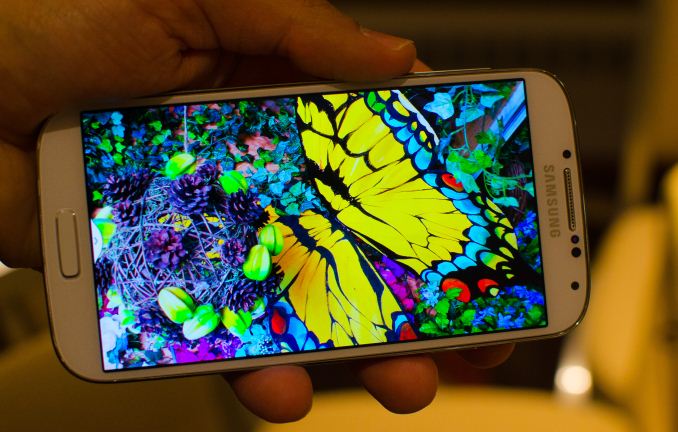
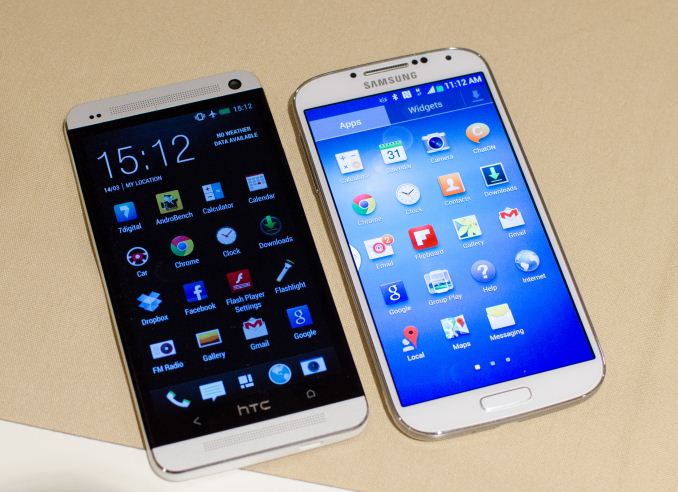

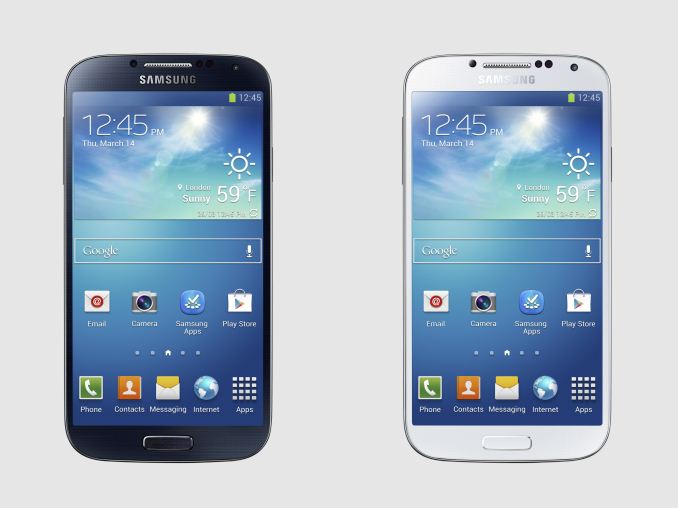
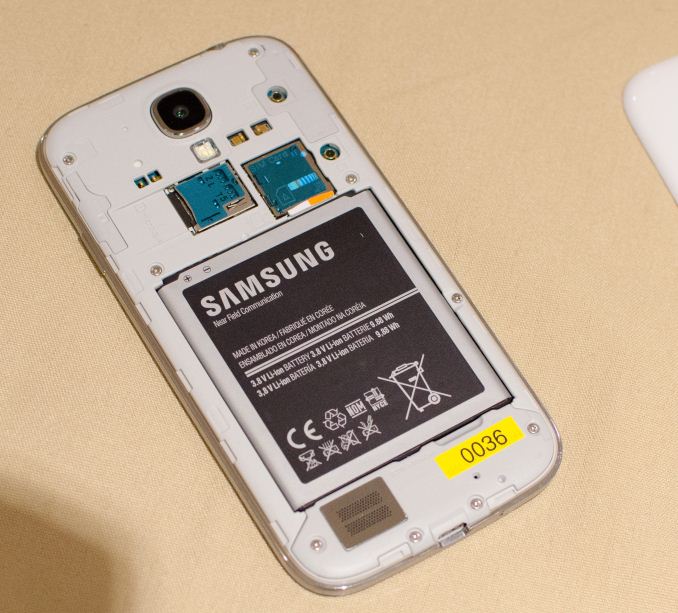
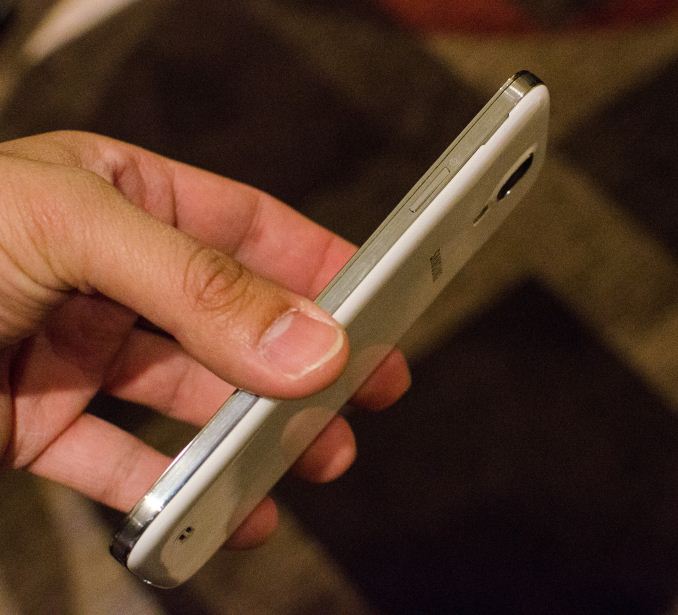















206 Comments
View All Comments
tommydaniel - Thursday, March 14, 2013 - link
The S3 does have a stripe around it that is made to look somewhat metal-ish but is indeed plastic..CeriseCogburn - Saturday, March 16, 2013 - link
The iPhone4 is a lead weight - if belongs in an auto mechanics tool chest, not as a portable phone, and it's tiny screen is a health hazard.That's "quality" to our retard drooling monkeys, though.
Then they drop it, it shatters front or back or both, and they say " Damn! that really felt good, it's a high quality build !"
RETARDS.
RETARDED.
RETARDS
RETARDED
CeriseCogburn - Saturday, March 16, 2013 - link
You and all the appl wouldabee fanboys need to feel good when they rub their phone, it's their only companionship after all. The only hardware they will ever be holding in their hands.How it feels matters because they can't use it, they just drool on it while they stare at it's "feel", then they buy a cover anyway.
It's how retards function, which is too say, they are tamponic.
kpb321 - Thursday, March 14, 2013 - link
Interesting. If the A15 cores are only clocked at 1.2ghz max the Qualcom quad core will probably offer higher max performance. The Exynos 5 Octa may offer better battery life if it can spend most of its time using the A7 cores especially at lower clocks. I'd bet the US will get the Qualcom processor as that has been the trend lately.Aenean144 - Thursday, March 14, 2013 - link
Yeah. A 1.2 GHz Cortex-A15 doesn't sound all that competitive to a 1.5 GHz Krait or Swift, and it appears 2013 Kraits will be in the 1.6 to 1.9 GHz range. If 1.2 GHz is truly the max, either Samsung has put something extra in the Cortex-A15 to make competitive or they are going to be crushed by Kraits shipping at about 50% more clock frequency.sleepeeg3 - Thursday, March 14, 2013 - link
Clock frequency is a meaningless comparison between different architectures. I can't believe that's still being brought up on this site, of all places.Aenean144 - Friday, March 15, 2013 - link
It's not meaningless if you have a sense of the performance per cycle for the different architectures.Krait is about 3.3 DMIPS/MHz. A15 is about 3.5 DMIPS/MHz. Cortex-A9 is about 2.5 DMIPS/MHz. Cortex-A7 is about 1.9 DMIPS/MHz. Work it out from there. I got this info from this site.
lmcd - Friday, March 15, 2013 - link
3.3 was an exaggeration, 3.5 an underestimate. See the A15 versus S4 Pro with the Nexus 10 v 4.Krysto - Friday, March 15, 2013 - link
Did you see any of the benchmarks for A15 yet? It gets much higher scores than than 7% more that those "official" DMIPS would let you believe. Why do you think Samsung underlocked the A15's to 1.6 Ghz? They didn't want the international version to be much faster.Aenean144 - Friday, March 15, 2013 - link
Ok, are the A15 cores in the SG4 clocked at 1.6 GHz or 1.2 GHz? Anand is saying 1.2 GHz as of the original publishing of the article.Of course the DMIPS could be off by a bit, it's saying the Cortex-A15 is about 5 to 15% faster. Will it be off by 50% if the A15s are only clocked 1.2 GHz? Seems like a whole lot of performance to make up. I'm sure there are specific ops on an A15 that outperform a +50% clocked Krait, but on average? I'm kind of doubting it right. Wait and see.